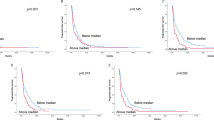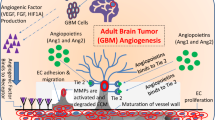Abstract
Purpose
Although erythropoietin (EPO) has been proven to significantly promote the proliferation of cancer cells, the mechanism for promoting glioma proliferation is poorly understood. Here, we examined the functional role of the AKT/GSK-3β/β-catenin signaling pathway in the EPO-mediated proliferation of glioma.
Methods
The distribution of EPO and Ki-67 among clinical samples with different WHO grades was plotted by Immunological Histological Chemistry analysis. U87 and U251 glioma cell lines were treated with short hairpin RNA targeting (shEPO), recombinant human erythropoietin (rhEPO) and/or AKT-specific inhibitor (MK-2206). The changes in phosphorylated AKT, nuclear β-catenin, cyclin D1 and p27kip1 expression were detected. Cell cycle distributions and glioma proliferation in vitro and in vivo were analyzed.
Results
The expression level of EPO was significantly elevated with the increase of WHO grade and Ki67 in clinical glioma specimens. In vitro, knockdown of endogenous EPO in U87 and U251 cells effectively block the phosphorylation of AKT and GSK-3β and the expression of nuclear β-catenin. shEPO treatment also significantly decreased the expression of cyclin D1 and increased the expression of p27kip1. The cell cycle transition then slowed down and the proliferation of glioma cells or mouse xenograft tumors both decreased. Treatment of cells or tumors with extra rhEPO reversed the above biological effects mediated by shEPO. rhEPO-induced activation of the AKT/GSK-3β/β-catenin pathway and proliferation were abolished by MK-2206.
Conclusions
Our study identified the AKT/GSK-3β/β-catenin axis as a critical mediator of EPO-induced glioma proliferation and further provided a clinically significant dimension to the biology of EPO.




Similar content being viewed by others
Data availability
The datasets used and/or analyzed during the current study are available from the corresponding author upon reasonable request.
Abbreviations
- EPO:
-
Erythropoietin
- GSK-3β:
-
Glycogen synthase kinase-3β
- rhEPO:
-
Recombinant human erythropoietin
- siRNA:
-
Short interfering RNA
- MK:
-
MK-2206
References
Juul SE, Yachnis AT, Christensen RD (1998) Tissue distribution of erythropoietin and erythropoietin receptor in the developing human fetus. Early Hum Dev 52(3):235–249
Bohlius J, Bohlke K, Lazo-Langner A (2019) Management of cancer-associated anemia with erythropoiesis-stimulating agents: ASCO/ASH clinical practice guideline update. J Oncol Pract 15(7):399–402. https://doi.org/10.1200/JOP.19.00111
Henke M, Laszig R, Rube C, Schafer U, Haase KD, Schilcher B, Mose S, Beer KT, Burger U, Dougherty C, Frommhold H (2003) Erythropoietin to treat head and neck cancer patients with anaemia undergoing radiotherapy: randomised, double-blind, placebo-controlled trial. Lancet 362(9392):1255–1260. https://doi.org/10.1016/S0140-6736(03)14567-9
Leyland-Jones B, Investigators B, Study G (2003) Breast cancer trial with erythropoietin terminated unexpectedly. Lancet Oncol 4(8):459–460
Ghezzi P, Bernaudin M, Bianchi R, Blomgren K, Brines M, Campana W, Cavaletti G, Cerami A, Chopp M, Coleman T, Digicaylioglu M, Ehrenreich H, Erbayraktar S, Erbayraktar Z, Gassmann M, Genc S, Gokmen N, Grasso G, Juul S, Lipton SA, Hand CC, Latini R, Lauria G, Leist M, Newton SS, Petit E, Probert L, Sfacteria A, Siren AL, Talan M, Thiemermann C, Westenbrink D, Yaqoob M, Zhu C (2010) Erythropoietin: not just about erythropoiesis. Lancet 375(9732):2142. https://doi.org/10.1016/S0140-6736(10)60992-0
Pham TD, Ma W, Miller D, Kazakova L, Benchimol S (2019) Erythropoietin inhibits chemotherapy-induced cell death and promotes a senescence-like state in leukemia cells. Cell Death Dis 10(1):22. https://doi.org/10.1038/s41419-018-1274-6
Annese T, Tamma R, Ruggieri S, Ribatti D (2019) Erythropoietin in tumor angiogenesis. Exp Cell Res 374(2):266–273. https://doi.org/10.1016/j.yexcr.2018.12.013
He L, Wu S, Hao Q, Dioum EM, Zhang K, Zhang C, Li W, Zhang W, Zhang Y, Zhou J, Pang Z, Zhao L, Ma X, Li M, Zhang Q (2017) Local blockage of self-sustainable erythropoietin signaling suppresses tumor progression in non-small cell lung cancer. Oncotarget 8(47):82352–82365. https://doi.org/10.18632/oncotarget.19354
Yu J, Wang X, Lu Q, Wang J, Li L, Liao X, Zhu W, Lv L, Zhi X, Yu J, Jin Y, Zou Q, Ou Z, Liu X, Zhou P (2018) Extracellular 5'-nucleotidase (CD73) promotes human breast cancer cells growth through AKT/GSK-3beta/beta-catenin/cyclinD1 signaling pathway. Int J Cancer 142(5):959–967. https://doi.org/10.1002/ijc.31112
Lamanuzzi A, Saltarella I, Ferrucci A, Ria R, Ruggieri S, Racanelli V, Rao L, Annese T, Nico B, Vacca A, Ribatti D (2016) Role of erythropoietin in the angiogenic activity of bone marrow endothelial cells of MGUS and multiple myeloma patients. Oncotarget 7(12):14510–14521. https://doi.org/10.18632/oncotarget.7587
Miyake M, Goodison S, Lawton A, Zhang G, Gomes-Giacoia E, Rosser CJ (2013) Erythropoietin is a JAK2 and ERK1/2 effector that can promote renal tumor cell proliferation under hypoxic conditions. J Hematol Oncol 6:65. https://doi.org/10.1186/1756-8722-6-65
Ostrom QT, Gittleman H, Fulop J, Liu M, Blanda R, Kromer C, Wolinsky Y, Kruchko C, Barnholtz-Sloan JS (2015) CBTRUS statistical report: primary brain and central nervous system tumors diagnosed in the United States in 2008–2012. Neuro-oncology 17(Suppl 4):iv1–iv62. https://doi.org/10.1093/neuonc/nov189
Wang R, Zhang S, Chen X, Li N, Li J, Jia R, Pan Y, Liang H (2018) EIF4A3-induced circular RNA MMP9 (circMMP9) acts as a sponge of miR-124 and promotes glioblastoma multiforme cell tumorigenesis. Mol Cancer 17(1):166. https://doi.org/10.1186/s12943-018-0911-0
Peres EA, Valable S, Guillamo JS, Marteau L, Bernaudin JF, Roussel S, Lechapt-Zalcman E, Bernaudin M, Petit E (2011) Targeting the erythropoietin receptor on glioma cells reduces tumour growth. Exp Cell Res 317(16):2321–2332. https://doi.org/10.1016/j.yexcr.2011.06.011
Kawahara Y, Furuta T, Sabit H, Tamai S, Dong Y, Jiapaer S, Zhang J, Zhang G, Oishi M, Miyashita K, Hayashi Y, Nakada M (2019) Ligand-dependent EphB4 activation serves as an anchoring signal in glioma cells. Cancer Lett 449:56–65. https://doi.org/10.1016/j.canlet.2019.02.021
Anai S, Goodison S, Shiverick K, Hirao Y, Brown BD, Rosser CJ (2007) Knock-down of Bcl-2 by antisense oligodeoxynucleotides induces radiosensitization and inhibition of angiogenesis in human PC-3 prostate tumor xenografts. Mol Cancer Ther 6(1):101–111. https://doi.org/10.1158/1535-7163.MCT-06-0367
Chan KK, Matchett KB, Coulter JA, Yuen HF, McCrudden CM, Zhang SD, Irwin GW, Davidson MA, Rulicke T, Schober S, Hengst L, Jaekel H, Platt-Higgins A, Rudland PS, Mills KI, Maxwell P, El-Tanani M, Lappin TR (2017) Erythropoietin drives breast cancer progression by activation of its receptor EPOR. Oncotarget 8(24):38251–38263. https://doi.org/10.18632/oncotarget.16368
Bawadood AS, Al-Abbasi FA, Anwar F, El-Halawany AM, Al-Abd AM (2020) 6-Shogaol suppresses the growth of breast cancer cells by inducing apoptosis and suppressing autophagy via targeting notch signaling pathway. Biomed Pharmacother 128:110302. https://doi.org/10.1016/j.biopha.2020.110302
Zhu Y, Cheng Y, Guo Y, Chen J, Chen F, Luo R, Li A (2016) Protein kinase D2 contributes to TNF-alpha-induced epithelial mesenchymal transition and invasion via the PI3K/GSK-3beta/beta-catenin pathway in hepatocellular carcinoma. Oncotarget 7(5):5327–5341. https://doi.org/10.18632/oncotarget.6633
Acs G, Zhang PJ, McGrath CM, Acs P, McBroom J, Mohyeldin A, Liu S, Lu H, Verma A (2003) Hypoxia-inducible erythropoietin signaling in squamous dysplasia and squamous cell carcinoma of the uterine cervix and its potential role in cervical carcinogenesis and tumor progression. Am J Pathol 162(6):1789–1806. https://doi.org/10.1016/S0002-9440(10)64314-3
Xia W, Spector S, Hardy L, Zhao S, Saluk A, Alemane L, Spector NL (2000) Tumor selective G2/M cell cycle arrest and apoptosis of epithelial and hematological malignancies by BBL22, a benzazepine. Proc Natl Acad Sci USA 97(13):7494–7499
Wang L, Di L, Noguchi CT (2014) Erythropoietin, a novel versatile player regulating energy metabolism beyond the erythroid system. Int J Biol Sci 10(8):921–939. https://doi.org/10.7150/ijbs.9518
Miao S, Wang SM, Cheng X, Li YF, Zhang QS, Li G, He SQ, Chen XP, Wu P (2017) Erythropoietin promoted the proliferation of hepatocellular carcinoma through hypoxia induced translocation of its specific receptor. Cancer Cell Int 17:119. https://doi.org/10.1186/s12935-017-0494-7
Roy A, Ansari SA, Das K, Prasad R, Bhattacharya A, Mallik S, Mukherjee A, Sen P (2017) Coagulation factor VIIa-mediated protease-activated receptor 2 activation leads to beta-catenin accumulation via the AKT/GSK3beta pathway and contributes to breast cancer progression. J Biol Chem. https://doi.org/10.1074/jbc.M116.764670
Yang J, Nie J, Ma X, Wei Y, Peng Y, Wei X (2019) Targeting PI3K in cancer: mechanisms and advances in clinical trials. Mol Cancer 18(1):26. https://doi.org/10.1186/s12943-019-0954-x
Chong ZZ, Hou J, Shang YC, Wang S, Maiese K (2011) EPO relies upon novel signaling of Wnt1 that requires Akt1, FoxO3a, GSK-3beta, and beta-catenin to foster vascular integrity during experimental diabetes. Curr Neurovas Res 8(2):103–120
Alao JP (2007) The regulation of cyclin D1 degradation: roles in cancer development and the potential for therapeutic invention. Mol Cancer 6:24. https://doi.org/10.1186/1476-4598-6-24
Gao X, Fan L, Li H, Li J, Liu X, Sun R, Yu Z (2016) Hepatic injury is associated with cell cycle arrest and apoptosis with alteration of cyclin A and D1 in ammonium chloride-induced hyperammonemic rats. Exp Ther Med 11(2):427–434. https://doi.org/10.3892/etm.2015.2931
Bachs O, Gallastegui E, Orlando S, Bigas A, Morante-Redolat JM, Serratosa J, Farinas I, Aligue R, Pujol MJ (2018) Role of p27(Kip1) as a transcriptional regulator. Oncotarget 9(40):26259–26278. https://doi.org/10.18632/oncotarget.25447
Acknowledgements
We would like to thank Professor Xinggang Zhi for his technical assistance.
Funding
This research was supported by the National Natural Science Funds of China under Awards Nos. 81301630, 81401070 and 81771355, the Science and Technology Research Project of Chongqing Municipal Education Commission, China (Award No. KJ1500219), and the Science and Technology Project of Yuzhong District, Chongqing, China (Award No. 20150108).
Author information
Authors and Affiliations
Contributions
ZT and GH contributed to the conception and design. All authors had full access to the data and participated in the analysis and interpretation of the data. ZT was responsible for drafting the manuscript. All of the authors reviewed the manuscript before submission. All authors read and approved the final manuscript.
Corresponding author
Ethics declarations
Conflict of interest
The authors declare that they have no competing interests.
Ethical approval
The primary human brain tumor specimens were obtained from patients who provided informed consent under protocols approved by the Institutional Review Board of the First Affiliated Hospital of Chongqing Medical University. Animal experiments were approved by the Medical Ethics Committee of the First Affiliated Hospital of Chongqing Medical University. All procedures involving mice conformed to the Guide for the Care and Use of Laboratory Animals published by the National Institutes of Health.
Additional information
Publisher's Note
Springer Nature remains neutral with regard to jurisdictional claims in published maps and institutional affiliations.
Electronic supplementary material
Below is the link to the electronic supplementary material.
Rights and permissions
About this article
Cite this article
Tang, Z., Yang, G., Wang, X. et al. AKT/GSK-3β/β-catenin signaling pathway participates in erythropoietin-promoted glioma proliferation. J Neurooncol 149, 231–242 (2020). https://doi.org/10.1007/s11060-020-03602-9
Received:
Accepted:
Published:
Issue Date:
DOI: https://doi.org/10.1007/s11060-020-03602-9




